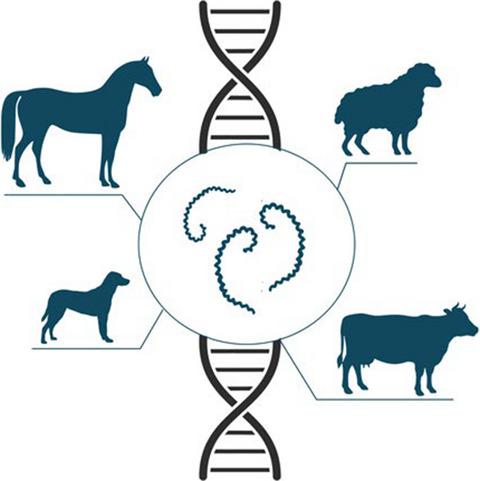当前位置:
X-MOL 学术
›
Lett. Appl. Microbiol.
›
论文详情
Our official English website, www.x-mol.net, welcomes your
feedback! (Note: you will need to create a separate account there.)
An overview on the molecular diagnosis of animal leptospirosis
Letters in Applied Microbiology ( IF 2.0 ) Pub Date : 2020-12-17 , DOI: 10.1111/lam.13442 Maria Isabel Nogueira Di Azevedo 1 , Walter Lilenbaum 1
Letters in Applied Microbiology ( IF 2.0 ) Pub Date : 2020-12-17 , DOI: 10.1111/lam.13442 Maria Isabel Nogueira Di Azevedo 1 , Walter Lilenbaum 1
Affiliation

|
The most common presentation of animal leptospirosis is the subclinical and silent chronic form, that can lead to important reproductive disorders. The diagnosis of this chronic form remains a challenge. The aim of the present study is to gather and critically analyse current information about molecular tools applied to animal leptospirosis diagnosis, particularly the silent chronic presentation of the infection. Regarding clinical specimens, samples from urinary tract were the most used (69/102, 67.7%), while few studies (12/102, 11.8%) investigated samples from reproductive tract. Concerning the molecular methods applied, the most used is still the conventional PCR (46/102, 45%), followed by real-time PCR (38/102, 37.2%). The lipL32 gene is currently the most common target used for Leptospira detection, with 48% of studies applying this genetic marker. From all the studies, only few (21/102, 20.5%) performed gene sequencing. According to the majority of authors, current evidence suggests that lipL32-PCR is useful for an initial screening for Leptospira DNA detection in animal clinical samples. Posteriorly, if DNA sequencing could be performed on positive lipL32-PCR samples, we encourage the use of secY gene as genetic marker. The molecular methods appear as the most important tools for the diagnosis of the chronic silent leptospirosis on domestic animals, reinforcing its evident impact not only on animal reproduction but also on a One Health context.
中文翻译:

动物钩端螺旋体病分子诊断概述
动物钩端螺旋体病最常见的表现是亚临床和无症状的慢性形式,可导致重要的生殖障碍。这种慢性形式的诊断仍然是一个挑战。本研究的目的是收集和批判性分析有关应用于动物钩端螺旋体病诊断的分子工具的当前信息,特别是感染的无声慢性表现。在临床标本方面,使用最多的是泌尿道样本(69/102,67.7%),而很少有研究(12/102,11.8%)调查生殖道样本。关于所应用的分子方法,使用最多的仍然是常规PCR(46/102,45%),其次是实时PCR(38/102,37.2%)。lipL32 基因是目前最常用的钩端螺旋体检测靶标,48% 的研究应用了这种遗传标记。在所有研究中,只有少数 (21/102, 20.5%) 进行了基因测序。大多数作者认为,目前的证据表明 lipL32-PCR 可用于动物临床样本中钩端螺旋体 DNA 检测的初步筛选。之后,如果可以对阳性 lipL32-PCR 样本进行 DNA 测序,我们鼓励使用 secY 基因作为遗传标记。分子方法似乎是诊断家畜慢性无症状钩端螺旋体病的最重要工具,加强了其不仅对动物繁殖而且对 One Health 环境的明显影响。目前的证据表明,lipL32-PCR 可用于动物临床样本中钩端螺旋体 DNA 检测的初步筛选。之后,如果可以对阳性 lipL32-PCR 样本进行 DNA 测序,我们鼓励使用 secY 基因作为遗传标记。分子方法似乎是诊断家畜慢性无症状钩端螺旋体病的最重要工具,加强了其不仅对动物繁殖而且对 One Health 环境的明显影响。目前的证据表明,lipL32-PCR 可用于动物临床样本中钩端螺旋体 DNA 检测的初步筛选。之后,如果可以对阳性 lipL32-PCR 样本进行 DNA 测序,我们鼓励使用 secY 基因作为遗传标记。分子方法似乎是诊断家畜慢性无症状钩端螺旋体病的最重要工具,加强了其不仅对动物繁殖而且对 One Health 环境的明显影响。
更新日期:2020-12-17
中文翻译:

动物钩端螺旋体病分子诊断概述
动物钩端螺旋体病最常见的表现是亚临床和无症状的慢性形式,可导致重要的生殖障碍。这种慢性形式的诊断仍然是一个挑战。本研究的目的是收集和批判性分析有关应用于动物钩端螺旋体病诊断的分子工具的当前信息,特别是感染的无声慢性表现。在临床标本方面,使用最多的是泌尿道样本(69/102,67.7%),而很少有研究(12/102,11.8%)调查生殖道样本。关于所应用的分子方法,使用最多的仍然是常规PCR(46/102,45%),其次是实时PCR(38/102,37.2%)。lipL32 基因是目前最常用的钩端螺旋体检测靶标,48% 的研究应用了这种遗传标记。在所有研究中,只有少数 (21/102, 20.5%) 进行了基因测序。大多数作者认为,目前的证据表明 lipL32-PCR 可用于动物临床样本中钩端螺旋体 DNA 检测的初步筛选。之后,如果可以对阳性 lipL32-PCR 样本进行 DNA 测序,我们鼓励使用 secY 基因作为遗传标记。分子方法似乎是诊断家畜慢性无症状钩端螺旋体病的最重要工具,加强了其不仅对动物繁殖而且对 One Health 环境的明显影响。目前的证据表明,lipL32-PCR 可用于动物临床样本中钩端螺旋体 DNA 检测的初步筛选。之后,如果可以对阳性 lipL32-PCR 样本进行 DNA 测序,我们鼓励使用 secY 基因作为遗传标记。分子方法似乎是诊断家畜慢性无症状钩端螺旋体病的最重要工具,加强了其不仅对动物繁殖而且对 One Health 环境的明显影响。目前的证据表明,lipL32-PCR 可用于动物临床样本中钩端螺旋体 DNA 检测的初步筛选。之后,如果可以对阳性 lipL32-PCR 样本进行 DNA 测序,我们鼓励使用 secY 基因作为遗传标记。分子方法似乎是诊断家畜慢性无症状钩端螺旋体病的最重要工具,加强了其不仅对动物繁殖而且对 One Health 环境的明显影响。











































 京公网安备 11010802027423号
京公网安备 11010802027423号